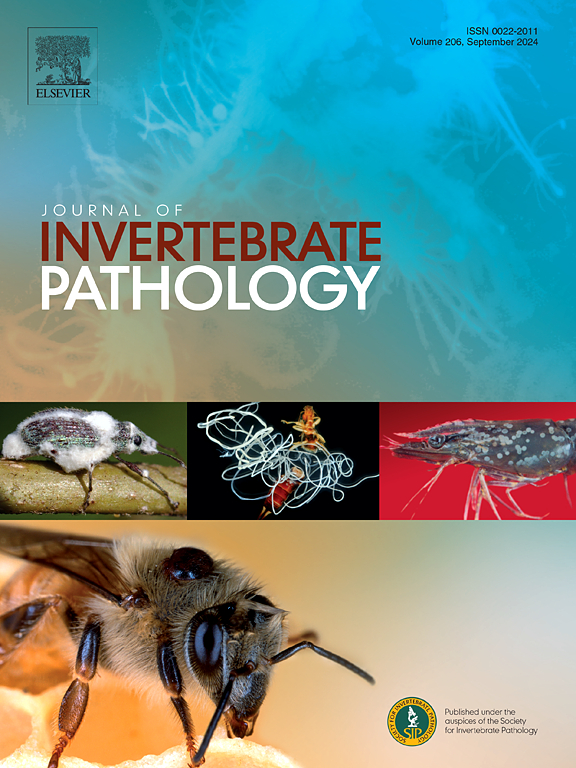用一种新的多重PCR方法准确、快速地检测对虾中6种病毒病原体
IF 2.4
3区 生物学
Q1 ZOOLOGY
引用次数: 0
摘要
对虾病毒性疾病,主要由陶氏综合征病毒(TSV)、白斑综合征病毒(WSSV)、感染性皮下和骨髓坏死病毒(IHHNV)/茎尖对虾病毒1型(PstDV1)、肝胰腺细小病毒(HPV)、单斑对虾型杆状病毒(MBV)/P引起。裸眼单胞病毒(PmNV)和黄头病毒(YHV)对对虾养殖业构成了重大的全球挑战,并造成了巨大的经济损失。本研究根据病毒高度保守的序列,设计了上述六种病毒的六对特异性引物,扩增每个病毒的保守基因片段,生成不同大小的相应PCR产物。在系统优化的基础上,建立了在对虾中同时检测和区分上述6种病毒的多重PCR方法。该方法特异性高,与其他非靶虾病毒或对虾核酸无交叉反应性。多重PCR检测TSV、WSSV、IHHNV、HPV和YHV的检出限为5 × 102 copies/μL, MBV的检出限为5 × 103 copies/μL。使用该方法,将1180个虾样本分为236个池,每个池5个样本进行进一步评估。所有池的总阳性率为30.5%,其中IHHNV为22.88%,WSSV为7.2%,HPV为0.42%,TSV、MBV和YHV未检出。多重PCR检测结果与常规单重PCR及实时单重PCR检测结果的符合率均大于98.5%。总的来说,本研究开发的多重PCR是检测和日常监测对虾TSV、WSSV、IHHNV、HPV、MBV和YHV的一种敏感和经济的诊断工具。本文章由计算机程序翻译,如有差异,请以英文原文为准。

Accurate and rapid detection of six viral pathogens in penaeid shrimp by using a novel multiplex PCR
Shrimp viral diseases, primarily caused by Taura syndrome virus (TSV), white spot syndrome virus (WSSV), infectious hypodermal and hematopoietic necrosis virus (IHHNV)/Penaeus stylirostris penstyldensovirus 1 (PstDV1), hepatopancreatic parvovirus (HPV), Penaeus monodon-type baculovirus (MBV)/P. monodon nudivirus (PmNV) and yellow head virus (YHV), posed a significant global challenge and resulted in enormous financial losses in the shrimp cultivation industry. In this research, six pairs of specific primers of the above six viruses were designed according to the highly conserved sequences of the viruses to amplify conserved gene segments of each virus and generate the corresponding PCR products of different sizes. Following system optimization, a multiplex PCR method was established to simultaneously detect and differentiate the six viruses mentioned above in penaeid shrimp. The assay exhibited high specificity with no cross-reactivity towards other non-target shrimp viruses or shrimp nucleic acids. The limit of detection (LOD) of the multiplex PCR assay was 5 × 102 copies/μL for TSV, WSSV, IHHNV, HPV and YHV, and 5 × 103 copies/μL for MBV. Using this assay, 1180 shrimp samples that were divided into 236 pools of five samples each pool were tested for further assessment. The total positive rate for all pools was 30.5 %, with IHHNV at 22.88 %, WSSV at 7.2 %, HPV at 0.42 %, and TSV, MBV, and YHV were undetected. The agreement rates between the multiplex PCR and conventional singleplex PCRs as well as real-time singleplex PCRs were all higher than 98.5 %. Overall, the multiplex PCR developed here is thus a sensitive and cost-effective diagnostic tool for the detection and daily monitoring of TSV, WSSV, IHHNV, HPV, MBV and YHV in shrimps.
求助全文
通过发布文献求助,成功后即可免费获取论文全文。
去求助
来源期刊
CiteScore
6.10
自引率
5.90%
发文量
94
审稿时长
1 months
期刊介绍:
The Journal of Invertebrate Pathology presents original research articles and notes on the induction and pathogenesis of diseases of invertebrates, including the suppression of diseases in beneficial species, and the use of diseases in controlling undesirable species. In addition, the journal publishes the results of physiological, morphological, genetic, immunological and ecological studies as related to the etiologic agents of diseases of invertebrates.
The Journal of Invertebrate Pathology is the adopted journal of the Society for Invertebrate Pathology, and is available to SIP members at a special reduced price.

 求助内容:
求助内容: 应助结果提醒方式:
应助结果提醒方式:


